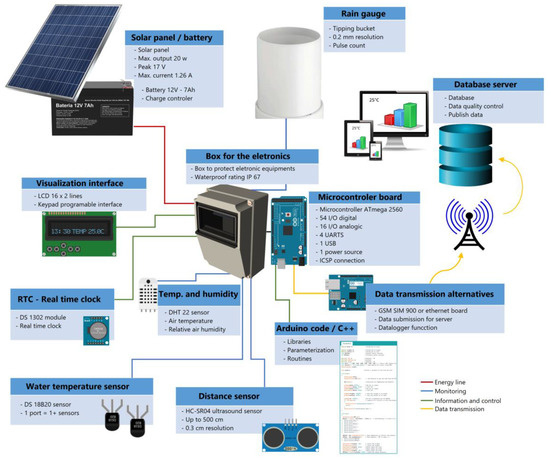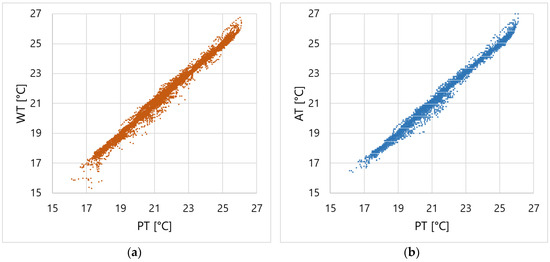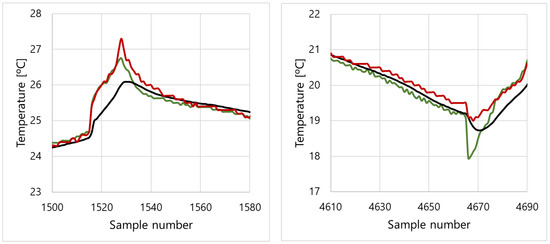Abstract
To properly manage water resources, data acquisition through environmental monitoring is required. However, the cost of professional sophisticated hydrological monitoring equipment may be prohibitive for many locations around the world. This work aims to develop a low-cost data collection platform (L-DCP) to be used to densify the hydrological monitoring network for rainfall, small rivers level and water temperature. Low cost sensors were compared to professional ones and presented an excellent correlation, with the coefficient of determination higher than 0.99 for temperature. The L-DCP was kept activated and collecting data for over 150 days without major problems. The low-cost solution has approximately 9% of the cost of a professional solution.
1. Introduction
To properly manage water resources, data acquisition through environmental monitoring is required. The use of water resources requires the knowledge of water availability based on the best available information [1]. Field monitoring allows us to identify changes that may occur in the hydrological regime as a result of climate change, land use and occupation and water use. Within the past decades, plenty hydrological monitoring instruments have been developed and are commercialized, presenting a significant advance in the capability to generate large hydrological databases to support engineers and decision makers. Several remote and near real-time monitoring systems have been deployed by scientific institutions, governmental agencies and industries [2]. However, the cost of sophisticated hydrological monitoring equipment may be prohibitive for many locations around the world, mainly to monitor small watersheds or even for the densification of hydrological networks [3]. There is virtually no hydrological monitoring of small watersheds to support local projects, small cities and farmers [4]. One of the reasons is because there are few cost-effective technologies available. This work aims to develop a low-cost data collection platform (L-DCP) to be used to densify the hydrological monitoring network for rainfall, air humidity and temperature, the level of small rivers, and water temperature. The prototype of the L-DCP was based on the Arduino [5] electronic platform associated with low-cost sensors like GSM shield, temperature sensor, real- time clock, a solar panel and a 12 V/7Ah battery. The L-DCP was developed to present the following functions: (1) real-time monitor of parameters like precipitation, water level and water temperature with reliability, (2) capacity for data storage in the L-DCP. (3) Data transmission to a data server. This work is the first step towards a local, cost-effective solution for a hydrological and environmental monitoring platform capable of delivering data with enough quality and reliability, to be used as an alternative to densify the hydrological network in small watersheds. These L-DCP initiatives will not be substitutes for official hydrological networks. However, this equipment may be used to provide data for a secondary network to support decision makers from small cities, small watersheds [4] and farmers to manage their water resources.
2. Materials and Methods
The equipment used in this study can be divided into two main sections. The professional sensors and datalogger are used as references and considered as high-cost sensors (HCS) and the equipment used on the L-DCP is considered as a low-cost sensor (LCS). Table 1 presents a list of the main equipment used in the study, excluding parts that are similar for both DCPs. Besides the professional equipment used to build a DCP, the table also presents a water quality multiprobe cost, which was used to generate water temperature to compare the results with the L-DCP. In the beginning of the experiment, the HCS for temperature was the one from the multiprobe. However, along the experiment, it stopped working and we changed it to the one named here as “Professional temperature sensor”.

Table 1.
Summary of the equipment used, and the costs.
The experimental setup was based on assembling two DCPs. The first DCP was assembled using HCS, which is well stablished equipment, usually deployed for continuous environment monitoring in the State of Santa Catarina, Brazil. The second assembly was named L-DCP, where LCS were used. The LCS used are easily obtained, nowadays, in any electrotechnics store. For this project, an infrastructure of a data server with oracle database was available. The server is already used to store environmental data from the State of Santa Catarina. The database structure is an expensive part of the system, but this was not the object of the present study. Lower cost alternatives for the database are available nowadays [6,7,8].
The L-DCP assemble schematics can be observed in Figure 1. The colored lines represent the different connections and functions on the assemble. The red line is related to the power supply, the green line represents the part of the equipment used for basic operation, the blue lines represent sensors connected for environment monitoring and the yellow line is related to the data transmission.

Figure 1.
This is an image with the schematics of the L-DCP.
The code was developed to meet the needs of the study. However, the libraries that control the sensors, except for tipping bucket rain gauge, were obtained directly from the Arduino IDE and are therefore easily accessible to any user. The Arduino IDE used for programming the microcontroller board is opensource and can be downloaded from the internet [5], while the software for the professional solution is proprietary and payed. Although, it is important to notice that the Arduino board will require more programming knowledge than the professional solution, which has a friendlier interface and requires less programming knowledge.
After assembling the DCP and L-DCP, a series of tests to check for the reliability of the measurements was performed. The first test was to check the tipping bucket rain gauge. Each tip produces an electrical pulse that should accumulate on the counter. The test was, basically, count the number of tips simulated manually and check if the L-DCP correctly counted the number of tips. To convert the number of tips to rain height, one should multiply the tipping counts by the rain gauge capacity. In this case, a typical rain gauge was used and each tip accounts for 0.2 mm of rain height. The second test aimed to check the stability of the temperature readings comparing the time series of the HCS with the LCS using determination coefficient (R2) and average values. All the sensors were put near each other in a room while sampling the temperature. The third test checked the distance sensor capacity of reliably reproducing a known distance. The fourth test aimed to evaluate the capacity of the L-DCP to store measured data in a SD card and send information to a data server using a GPRS (General Packet Radio Services) modem. Finally, the L-DCP was kept in operation for over 5 months (156 days) to evaluate its working capacity and the durability of the used LCS.
3. Results and Discussion
The first step was to test the tipping bucket counter. This is a simple implementation and resulted in 100% accuracy. It was possible to count all pulses without detecting any error on pulse readings. The only error that may occur is in the tipping bucket of the rain gauge itself. But, in this case, both L-DCP or DCP will present errors in rain measurements.
The second test aimed to check the low-cost temperature sensors for water and air with the professional temperature sensors. More than 9300 sensor readings were used in this test and the results are presented in Figure 2. The acronyms used to identify the sensors are as follows: WT (water temperature low-cost sensor); AT (air temperature low-cost sensor); PT (professional temperature high-cost sensor). The temperature variation measured during the experiment was from a minimum of 16.1 °C to a maximum of 27.3 °C.

Figure 2.
Results obtained comparing the time series of (a) Water temperature low-cost sensor (WT) vs. PT and (b) air temperature low-cost sensor (AT) vs. PT.
We used the temperature measurements of the PT as reference. The results show that WT and AT presented similar results to the measurements of PT. The average values of the PT, WT and AT sensors are 21.8 ± 2.2, 21.7 ± 2.3 and 21.8 ± 2.2, respectively. This is strong evidence that it is possible to use L-DCP to monitor water and air temperature. Another result that corroborates it is the R2 of 0.991 and 0.992 for WT/PT and AT/PT, respectively. It is important to mention that, although the results are excellent, it is possible to identify, in Figure 2, that there is some dispersion of the measured values. Part of this dispersion may be explained by an experimental error. All the sensors were physically close to each other. However, the PT sensors were submerged in a 400 mL flask of tap water; meanwhile, the WT and AT sensors were out of the water. Therefore, the differences observed in Figure 3 should be partially explained by the difference on the heat transfer kinetics of air and water in events of sudden variation of air temperature. Besides, the PT sensor obtained more stable values.

Figure 3.
Differences on the temperature measurements in PT (black line), AT (red line) and WT (green line) for two distinct moments of the same sensors.
The distance sensor, to be used in water level measurements, was mounted over a structure with 32 cm from the sensor until a physical barrier. More than 13,000 readings were taken. However, some of the readings cannot be used, due to reading errors. A total of 348 misreading occurred, equivalent to 2.7% of errors over the period. Despite the errors, the useful readings resulted in an average value of 32.2 ± 0.4 cm, an excellent result with a small deviation. The distance routine should be reprogramed to reduce the chance of getting erroneous values. This could be done by implementing a checking routine based on the standard deviation of a series of readings. If the standard deviation does not meet a pre-defined maximum value, new readings may be acquired in a pre-define maximum loop. The sensor was tested measuring distance to a physical barrier. The next step is to test the sensor reading a water surface associated with turbulence with high frequency ripples.
All readings taken during the experiment were saved to the SD card associated with the microcontroller. We achieved 100% success in storing data, fully fulfilling its function. It was also possible to continuously transmit data to the data server over a protocol using HTTP POST request. Two Arduino modules were tested, an ethernet module and a GPRS module. The ethernet module worked properly, but can be used only in sites where internet connection is available. Besides, it consumes to much energy, rapidly depleting the battery. The GPRS module worked, but there was a significant increase in data transmission failure. To reduce the number of transmission failures, an additional routine should be implemented to check if the data is received by the server and, if not, make new attempt.
The L-DCP was operating and collecting data for over 150 days without major problems. None of the LCS stopped working during this time. Whereas automatic stations maintenance visits should be no more than 3 months intervals (90 days), it can be assumed that this equipment can be used continuously. Besides, the cost of a DCP solution currently used is € 4950, while the L-DCP solution resulted in € 450. These costs do not consider the protection box and metallic support structure that are needed for both platforms. So, the L-DCP is about 9.1% of the cost of the professional solution. Additionally, if we consider only the sensors, the cost of LCS represents only 2% of the HCS.
During the development of the tests, one major problem is the high energy consumption. Some parts of the assembly have been removed, such as voltage regulator and LCD screen, but the problem persists.
4. Conclusions
The results demonstrate a great potential to use a low-cost solution as an alternative to densify the hydrological network in small watersheds providing reliable data. L-DCP may cost less than 10% of a professional solution. Moreover, considering only the LCS, it may represent only 2% of the HCS.
The L-DCP still requires several refinements, such as adapting the program to reduce errors in data transmission using GPRS, optimizing equipment power consumption to avoid battery depletion problems during low solar radiation periods and testing the water level sensor over a water surface with high frequency ripples.
It is also important to do long-term durability testing of L-DCP exposed to the adverse weather conditions. Furthermore, it is important to plan for additional implementation, such as updating RTC module time based on GPRS network time, ensuring the correct date and time of the data collection.
L-DCP will not substitute official hydrological networks. However, it can provide sufficiently reliable data to support small watersheds decision makers and farmers to manage their water resources.
Author Contributions
L.H.P.G. conceived and designed the experiments; L.H.P.G. and A.L.N. performed the experiments; L.H.P.G. and K.R.L. analyzed the data; L.H.P.G. wrote the paper; A.L.N. and K.R.L. reviewed and edited the paper.
Acknowledgments
The research work was funded by EPAGRI, which provided the necessary equipment and infrastructure to carry out the work.
Conflicts of Interest
The authors declare no conflict of interest.
References
- Santos, P.V.C.; Cunha, A.C. Outorga de Recursos Hídricos e Vazão Ambiental no Brasil: Perspectivas Metodológicas Frente ao Desenvolvimento do Setor Hidrelétrico na Amazônia. Rev. Bras. Recur. Hídricos 2013, 18, 81–95. [Google Scholar] [CrossRef]
- Daokun, M.; Qisheng, D.; Zhenbo, L.; Daoliang, L.; Yaoguang, W. Prototype of an Aquacultural Information System Based on Internet of Things E-Nose. Intell. Autom. Soft Comput. 2013, 18, 569–579. [Google Scholar] [CrossRef]
- WMO. The 5 Essential Elements of a Hydrological Monitoring Programme. World Meteorol. Organ. Bull. 2012, 61. Available online: https://public.wmo.int/en/bulletin/5-essential-elements- -hydrological-monitoring-programme (accessed on 17 September 2019).
- Garbossa, L.H.P.; Pinheiro, A. Vazões de referência para gestão de bacias hidrográficas rurais e urbanas sem monitoramento. Rev. Gestão Água América Lat. 2015, 12, 43–52. [Google Scholar] [CrossRef]
- Arduino. Available online: https://www.arduino.cc/ (accessed on 17 September 2019).
- MariaDB Foundation. Available online: https://mariadb.org/ (accessed on 17 September 2019).
- PostgreSQL. Available online: https://www.postgresql.org/ (accessed on 17 September 2019).
- SQLite. Available online: https://www.sqlite.org/index.html (accessed on 17 September 2019).
Publisher’s Note: MDPI stays neutral with regard to jurisdictional claims in published maps and institutional affiliations. |
© 2019 by the authors. Licensee MDPI, Basel, Switzerland. This article is an open access article distributed under the terms and conditions of the Creative Commons Attribution (CC BY) license (https://creativecommons.org/licenses/by/4.0/).